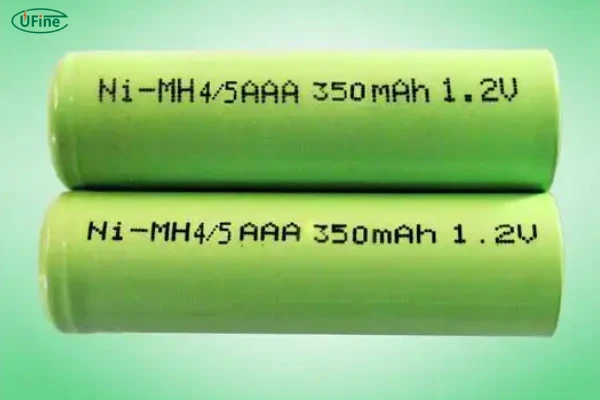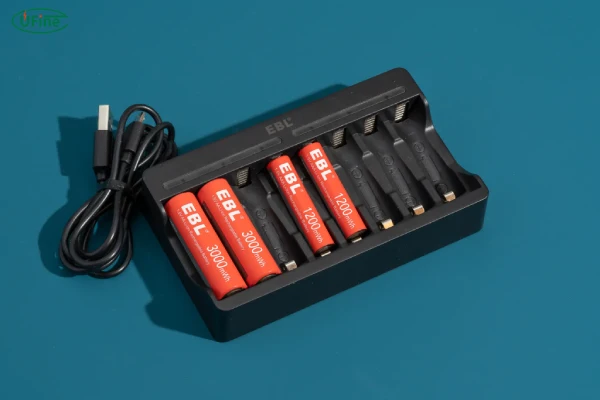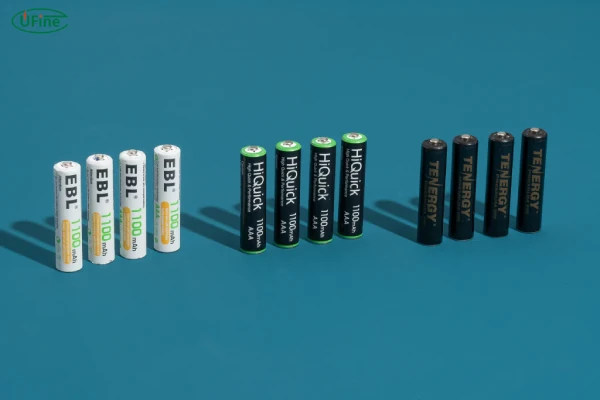If you’re someone who uses a lot of rechargeable batteries, then you’ve probably encountered the Ni-MH AAA battery at some point. But do you know exactly what makes these batteries so great, how they work, and how you can get the most out of them? In this comprehensive guide, we’ll dive deep into the world of Ni-MH AAA batteries, exploring everything from their chemistry to their applications, as well as their pros and cons.
By the end, you’ll have a much clearer understanding of what these batteries offer and why they might be the perfect choice for your needs.
Part 1. What is a Ni-MH AAA battery?
Let’s start with the basics: what exactly is a Ni-MH AAA battery?
Ni-MH stands for Nickel-Metal Hydride, which refers to the chemical composition inside the battery. Unlike disposable alkaline batteries, which are designed for single use, Ni-MH batteries are rechargeable. That’s one of their key selling points — they can be used over and over again, making them far more eco-friendly and cost-effective in the long run.
The AAA designation refers to the size of the battery. A standard Ni-MH AAA battery is 44.5mm in length and 10.5mm in diameter. It’s the same size as an alkaline AAA battery, so you can use them interchangeably in most devices.
Part 2. Voltage: what’s the difference?
When you’re buying batteries, voltage is one of the first things you’ll notice. Ni-MH AAA batteries typically have a voltage of 1.2V. You may wonder, “Isn’t that lower than the 1.5V of a regular alkaline battery?”
That’s true, but here’s the thing: although Ni-MH batteries have a lower voltage, they offer more stable performance over time. Alkaline batteries will start at 1.5V but quickly lose voltage as they discharge, while Ni-MH batteries provide consistent output throughout their lifespan. So, while the voltage is lower, the performance is usually better for devices that require a steady and reliable energy source.
Part 3. Size and shape
One of the best things about Ni-MH AAA batteries is that they come in the familiar AAA size. This makes them incredibly convenient for a wide range of devices, from remote controls to toys and flashlights.
To be precise, these batteries are 44.5mm in length and 10.5mm in diameter, which is the standard size for AAA batteries. They’re small, compact, and lightweight, so they fit easily into any device that requires this size. Whether you’re powering a high-tech gadget or a simple everyday item, you’ll find that the size and shape of Ni-MH AAA batteries make them versatile and easy to use.
Part 4. Chemistry: how do Ni-MH batteries work?
Ni-MH batteries use a chemical reaction between nickel (Ni) and metal hydride (MH). In the positive electrode (the anode), nickel compounds are used, while the negative electrode (the cathode) contains metal hydride.
Here’s where it gets interesting: the metal hydride allows for a higher energy density than traditional nickel-cadmium (Ni-Cd) batteries. This means Ni-MH batteries can hold more energy for their size, allowing them to run longer between charges.
Moreover, Ni-MH batteries don’t contain the toxic cadmium found in older Ni-Cd batteries, making them safer and more environmentally friendly.
Part 5. Lifespan: how long will they last?
The lifespan of a Ni-MH AAA battery depends on several factors, including the quality of the battery, how often it’s used, and how well it’s cared for. On average, a good-quality Ni-MH AAA battery can last between 500 and 1,000 charge cycles.
This means that with proper care, you can use a Ni-MH AAA battery for several years before it starts losing capacity. Of course, over time, batteries naturally degrade, but they will still perform better than disposable batteries, which only last until their charge is used up.
Pro Tip: To extend the lifespan of your Ni-MH batteries, try not to leave them in a charger once they’re fully charged. Overcharging can shorten their overall lifespan.
Part 6. Capacity: how much power do they hold?
Capacity refers to how much charge a battery can hold, and it’s usually measured in milliampere-hours (mAh). For Ni-MH AAA batteries, the typical capacity ranges from 600mAh to 1,200mAh.
What does that mean in practical terms? Higher-capacity batteries will power your devices for a longer period. However, keep in mind that high-capacity batteries may require more time to charge. The trade-off is that they’re better for high-drain devices like digital cameras or power-hungry toys.
For everyday items like remote controls or clocks, lower-capacity batteries may work just fine. But for gadgets that demand more power, a higher-capacity Ni-MH AAA battery will be your best bet.
Part 7. Advantages and disadvantages of Ni-MH AAA batteries
Every battery type has its pros and cons. Let’s look at the advantages and disadvantages of Ni-MH AAA batteries.
Advantages:
- Rechargeable: This is the big one. Ni-MH AAA batteries can be used hundreds of times before needing to be replaced. They’re better for the environment and your wallet.
- Environmentally Friendly: Unlike older Ni-Cd batteries, Ni-MH batteries don’t contain toxic cadmium, making them safer for disposal and recycling.
- Stable Performance: Ni-MH batteries provide steady power over time, which is great for devices that need consistent energy.
- Good for High-Drain Devices: If you’re using something that requires a lot of power, such as a digital camera or toy, Ni-MH batteries hold up better than regular alkaline batteries.
Disadvantages:
- Lower Voltage: As mentioned earlier, Ni-MH batteries have a lower voltage (1.2V vs. 1.5V for alkalines), which may not work as well for some devices that need the full 1.5V.
- Self-Discharge: Ni-MH batteries have a higher self-discharge rate than alkaline batteries, meaning they lose charge when not in use. However, low self-discharge (LSD) versions are now available, which hold their charge much longer.
Part 8. Ni-MH AAA battery pack: what’s the difference?
A Ni-MH AAA battery pack is essentially multiple individual Ni-MH AAA batteries connected together. These packs are typically used in devices that require a higher voltage or longer operating time, such as flashlights, power tools, or electric shavers.
The key difference between a single Ni-MH AAA battery and a battery pack is that the latter usually contains several cells, providing more total energy. For example, a pack of 4 Ni-MH AAA batteries will provide 4.8V (1.2V x 4), which is perfect for powering larger devices.
Part 9. Charging: How to do it right
Charging Ni-MH AAA batteries is straightforward, but it’s important to do it properly to extend their lifespan.
Here’s how to get the most out of your batteries:
- Use the right charger: Always use a charger designed for Ni-MH batteries. Using an incorrect charger can lead to overcharging or inefficient charging.
- Charge at room temperature: Extreme temperatures can affect the battery’s performance, so avoid charging in areas that are too hot or too cold.
- Don’t overcharge: Charging for too long can degrade the battery’s performance. Consider using a smart charger that automatically stops charging when the battery is full.
Part 10. What charger does Ni-MH AAA battery use?
Ni-MH batteries require a Ni-MH compatible charger. There are different types of chargers available:
- Smart chargers: These automatically detect when the battery is fully charged and stop charging to prevent overcharging.
- Universal chargers: Some chargers can handle different types of batteries, including Ni-MH, Ni-Cd, and lithium-ion batteries.
- Desktop chargers: Perfect for families or offices, these chargers allow you to charge multiple batteries at once.
NiMH Battery vs Li-Ion Battery vs NiCad Battery: How are they different?
Part 11. Applications of Ni-MH AAA batteries
Ni-MH AAA batteries are found in a wide range of devices. Some of the most common applications include:
- Remote controls: Since they require steady, low-power output, Ni-MH batteries are ideal for remotes.
- Toys: Many battery-operated toys now use Ni-MH AAA batteries because they’re rechargeable and long-lasting.
- Digital cameras: These high-drain devices benefit from Ni-MH batteries’ consistent power.
- Cordless phones: Ni-MH batteries can power cordless phones for hours of use.
Part 12. Price: how much do they cost?
In general, you can expect to pay anywhere from $1 to $3 per Ni-MH AAA battery. If you’re buying in bulk, you may get a discount, and buying a high-capacity battery will usually cost more. However, considering that these batteries are rechargeable, they save you money over time compared to disposable alternatives.
Part 13. Popular brands of Ni-MH AAA batteries
Here are five trusted brands that offer high-quality Ni-MH AAA batteries:
- Energizer
- Duracell
- Panasonic
- Eneloop (by Sanyo)
- AmazonBasics
These brands offer reliable, durable Ni-MH AAA batteries with excellent performance, and many come in both standard and low self-discharge varieties.
Part 14. Final thoughts
Ni-MH AAA batteries are a fantastic choice for anyone looking to reduce their environmental footprint while enjoying reliable, rechargeable power for everyday devices. While they may not offer the same high voltage as alkaline batteries, their consistent performance and long lifespan make them an ideal option for many people. Whether you’re using them for remotes, toys, or cameras, Ni-MH AAA batteries will serve you well for years to come.
Related Tags:
More Articles

How to Choose the Best Floor Scrubber Battery for Commercial Cleaning?
Selecting the ideal floor scrubber battery ensures a long runtime, rapid charging, and minimal maintenance for efficient commercial cleaning operations.
Battery for Blower vs Battery for Leaf Vacuum: Which One Should You Choose?
Battery for blower vs leaf vacuum—learn the key differences in power, fit, and runtime to choose the right battery for your outdoor tool needs.
How to Choose the Right Battery for Blower?
Choosing the right blower battery? Consider voltage, capacity, chemistry & usage. This guide helps match the best battery for peak performance.
How to Choose the Best Insulated Battery Box for Lithium Batteries?
Choosing the Best Insulated Battery Box for Lithium Batteries? Discover key factors such as size, material, and safety for optimal protection and performance.
7 Critical Elements on a Lithium Battery Shipping Label
What must be on a lithium battery shipping label? Learn 7 key elements to ensure safety, legal compliance, and correct handling across all transport modes.






